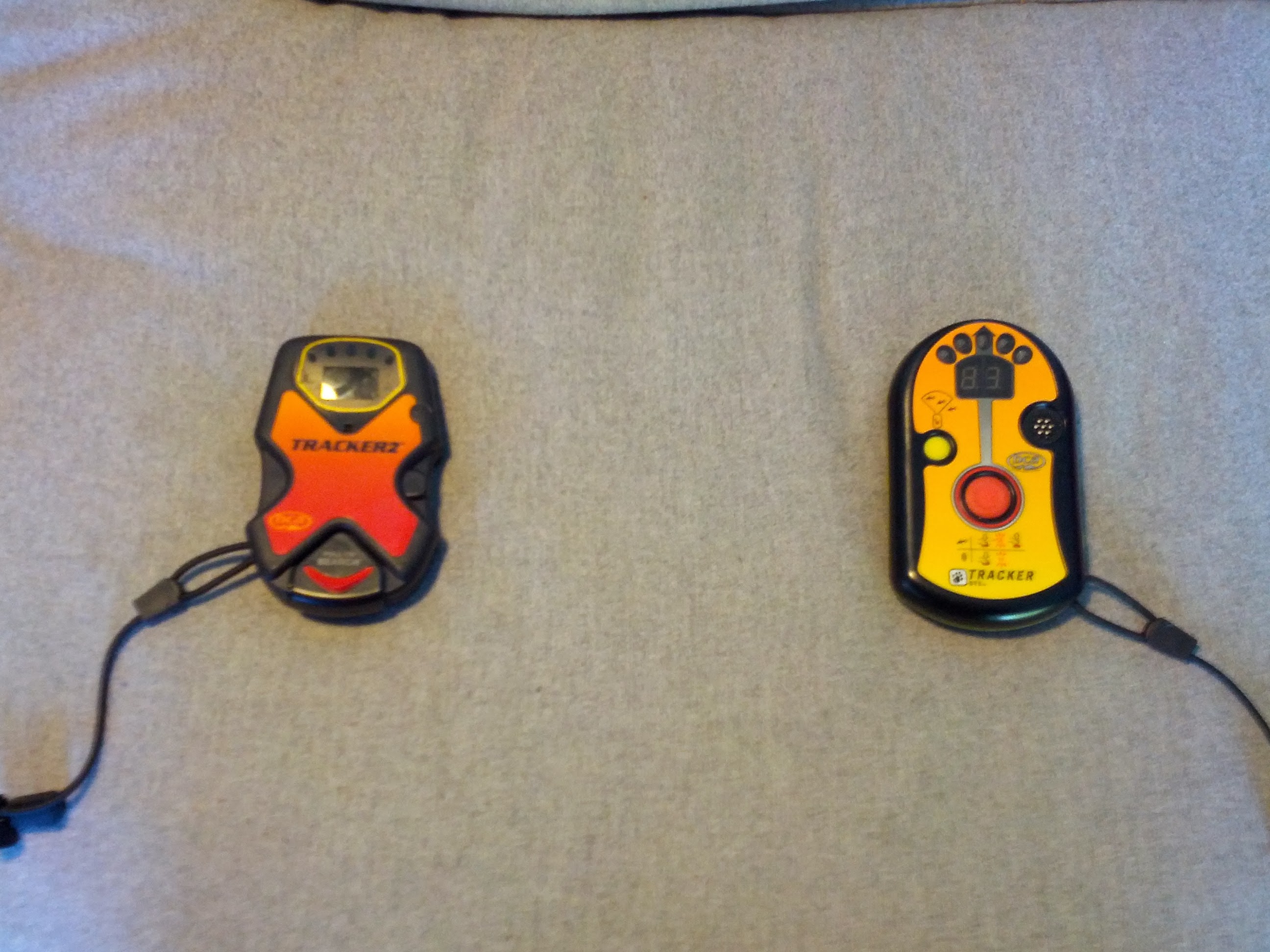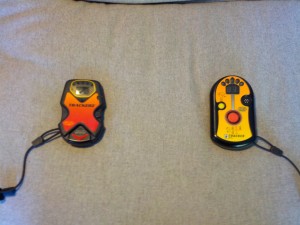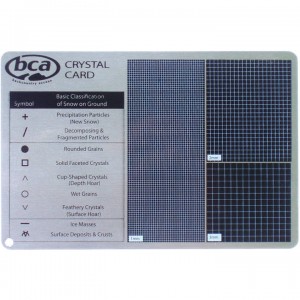Avalanche Transceivers and Tin Foil

I recorded the following video to demonstrate one of the many well known effects of tin foil, and other metals, on a radio frequency (RF) source.
Note, see the update at the end of this article.
Wrapping the beacon in aluminum foil attenuates the signal dramatically, but a factor of 10 or 20. Another way to say this is that it reduces the strength of the signal by an order of magnitude.
The fact is, tin foil hats work.
For the past few years there have been periodic flurries of concern (I hesitate to say “panic”) about the ability of cell phones to interfere with the functioning of an avalanche transceiver. The fact is that any RF source has the potential to interfere with another if the frequencies are similar, or if either is not properly shielded. I may go into some of the physics of this in another post, but for now I’ll outline the effect in the posted video.
Based on my first year physics courses, the tin foil acts as a very primitive Faraday Cage when wrapped around the transmitting beacon. It effectively attenuates the transmission of the 457 kHz signal from the sending beacon to the receiving beacon. The receiver, not knowing that the signal is attenuated, interprets this as being further away. An analogue transceiver would just beep at a lower volume, and the operator would probably interpret this as a deeper burial.
The signal is also attenuated by snow. A deeply buried person will “appear” to be further away than they really are.
Now, normally you wouldn’t wrap your beacon in tin foil, but if you are carrying a radio, cell phone, or other technological device with some metal in it, you might be able to attenuate the signal. Carrying your snow screen in your chest pocket over the beacon? How about all of the metal in your backpack?
In the paper titled “457 KHz Electromagnetism and the Future of Avalanche Transceivers,” co-authored by Bruce Edgerly who works for the company that makes both of the beacons in the video, they specifically make reference to the fact that aluminum doesn’t significantly limit the field strength of the beacon because transceivers are working in the “near field” where the effect of the signal is predominantly magnetic in nature, so I would not worry too much.
However, the US military began experiments into the effectiveness of metallic foils in insulating garments in 1978 and found them to be effective. If you Google “omni heat reflective” you will find a line of clothing by Columbia Sportswear that purports to “regulate your temperature with little silver dots that reflect and retain the warmth your body generates.” This grid of dots may be an effective Faraday cage for a 457 KhZ transceiver if the distance between the dots is smaller than the wavelength of the transmission – which it is.
I would love to hear from anyone out there who owns a garment with foil in it to see if we can replicate this experiment.
So while I don’t expect any of you to wrap your avalanche beacons in aluminum, you should keep in mind this effect if you’re making a clothing choice that includes metallic foils.
UPDATE
My SAR colleague Mike from Prince George SAR did the experiment with a an Omni-Heat jacket, and it has no perceptible effect on the signal. Based on the comments from Richard Buckley (see below), the Omni-heat does not form a “cage” because the foil is not connected and not grounded. Does anyone have any other garments with foil in them?
References
Recommendation on how avoid Interference Issues in companion and organized avalanche rescue, Genswein, Atkins, Obad, et al, Proceeedings of the 2013 International Snow Science Workshop, October 7-11, 2013, Grenoble Chamonix-Mont Blanc France.
Insulating Effectiveness of Metallized Reflective Layers in Cold Weather Clothing Systems, US Army Research Institute of Environmental Medicine, Natic Massachusetts, April 1978
457 KHz Electromagnetism and the Future of Avalanche Transceivers, John Hereford, Bruce Edgerly, Proceedings of the 2000 International Snow Science Workshop, October 1-6, Big Sky, Montana



Hi Michael,
An interesting article, and certainly something back country enthusiasts should be aware of. But associating potential attenuation sources with Faraday cages is misleading and could result in either over or under reaction. A Faraday cage must be a fully enveloping structure and have a conductive path to ground for the energy to dissipate through. A very dramatic display of what happens can be seen if you microwave a CD for a few seconds. http://www.youtube.com/watch?v=lKd92oU9ivs
With less energy the result of wrapping a low power transmitter is less dramatic, but the energy still has to go somewhere. Usually it will cause eddy currents in the foil that re-radiates as a radio wave.
Also a Faraday cage, say of the kind avionics shops use to certify ELT transmitters will provide attenuation of 50 dB or more, 5 orders of magnitude. Of course the comments about Avalanche Transceivers working in the near field and using predominantly the H-field (magnetic) aspect of the signal is quite correct. There is also diffraction around the edges if there isn’t full envelopment, and the Quantum properties of photons to defy all conventional logic when propagating from one place to another. If each dot in the grid is electrically isolated from the others, and the dots are much smaller than the wavelength of the signal, then they would probably have very little effect on the signal.
What is more important is that this material is also in the near field of the transmitter. The near field is different from the far field (how must of us use radio in every day life) in three important ways. First, the receiver (or the aluminum foil) in the near field is able to source a usable amount of energy from the transmitter. This is how tap and go payment cards work. The chip in the card is actually powered by the radio field generated by the point of sale device. Second, the transmitter is able to detect that energy draw. This is how the point of sale device can detect that the payment card is close. Third, materials within the near field of a transmitter affect the resonant properties of the transmitter and antenna. This is how adding a reflector and directors to an omnidirectional dipole antenna can change it into a direction Yagi-Uda antenna. I would not be surprised if, by detailed investigation, you would find that a large part of the range error is caused by the aluminium foil interfering with the ability of the transmitter from operating efficiently by taking it out of tune.
I don’t mean to be critical of Avalanche Transceivers here, but trying to determine absolute, or even relative distance between a transmitter and a receiver by using received signal strength is very difficult. Operating in the near field mitigates, but does not eliminate the issues.
Richard, one of the many reasons I write this blog is because of people like you commenting or replying by email, and the things I learn from them.
So while my explanation was off base, the effect is “measured” by the beacon.
One thing I agree with you on is the “ability” of the digital beacons to measure distance from the transmitter. When the digital beacons first came out the first thing we noticed was they all had much shorter ranges (from 90m to 45m in an extreme case), and the second thing we saw was that they had to “think” which resulted in a pause while the device processed the inputs.
As a software developer “in real life” I find myself wondering how easy it would be to trick a digital beacon. Are there some assumptions being made about the operating conditions that would result in edge or corner cases that might cause the device to flip out?
Why don’t all of these beacons have an analogue fail safe mode? In the case where the algorithm fails (and as I said in another forum today, the only constant in technology is that it always fails in some manner), you should be able to fall back on interpreting the strength of the signal by converting it to an audible beep.
Anyway, my demonstration was intended to show one of the many ways you can interfere with the beacon’s functioning, and based on a real life scenario. I figure that people need to understand that these devices are more complex than they seem to be however much we try to dumb down their operation.
In the bottom video (“Will Omni-Heat or GoPro wifi mess with avalanche transceivers?”), watch how the multiple burial light goes on when the gopro is held near. (time: 1:56).
That means the gopro is interfering with the searching beacon! This is the red light that looks like two letter “i”s next to each other. The searching beacon thinks there is more than one transmitting beacon near it.
To test the omni-heat, they should have walked away from the searching beacon until signal is lost with and without the beacon wrapped in the jacket to see if there is a difference. All that we can tell from this video is that omni-heat doesn’t prevent signal detection when the searching beacon is a couple inches away.